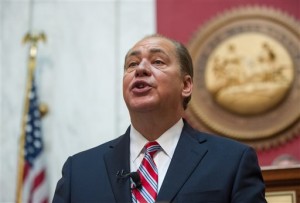Tomblin: Time to reinvest in W.Va. coalfields
January 13, 2016 by Ken Ward Jr. Tonight’s State of the State address from West Virginia Gov. Earl Ray Tomblin contained what were certainly the most straightforward comments from the governor on the state of the state’s coal industry:
Tonight’s State of the State address from West Virginia Gov. Earl Ray Tomblin contained what were certainly the most straightforward comments from the governor on the state of the state’s coal industry:
… We cannot ignore the unprecedented shift that has taken place in our state and our nation. Forces beyond our control have severely damaged our coal industry, and even the most optimistic among us realize it is unlikely coal will ever reach production levels of the past.
Pretty strong stuff, especially for Governor Tomblin. Right before that, though, he had said this:
Despite the difficult times we find ourselves in, West Virginia remains the fourth largest producer of electricity in the country, and I believe our coal industry will continue to support our families well into the future.
It’s true that the coal industry in West Virginia isn’t going to disappear overnight or anytime soon — but it’s still a problem that political leaders feel they need to balance any talk about the downward spiral with hope that it really won’t be quite all that bad.
The governor went on to say more about coal and about mining communities:
For generations, our miners unearthed the coal used to produce the low-cost energy that fueled this country’s Industrial Revolution – one that remains unmatched anywhere in the world. This nation owes these West Virginians a debt of gratitude and we are ready to cash in on that substantial IOU.
And he outlined several proposals for helping struggling coal communities.
First, there was this:
This fall, we submitted an application to the National Disaster Resilience Competition seeking more than $140 million in funding from the United States Department of Housing and Urban Development. This competition has the potential to help six counties in our southern coalfields adjust, adapt and advance their communities.
If we’re successful, these federal funds will help us rebuild aging infrastructure, promote land use planning and hazard reduction efforts and stimulate housing and economic development in areas outside of the region’s floodplains.
And then there was the big one:
We are also proposing to develop the largest industrial site in West Virginia history at the former Hobet surface mine in Boone and Lincoln counties. With 12,000 acres located just off Corridor G, this site is large enough to fit virtually every major economic development project in recent history – including Toyota, Procter & Gamble, Gestamp, Macy’s, Amazon and more – with thousands of acres left over.
We know this is a major undertaking, and with the help of local landowners Marshall University, West Virginia University and the Virginia Conservation Legacy Fund, we are working together to find new uses for this site while mining activity continues.
Photo of Hobet 21 mountaintop removal mining complex, by Vivian Stockman, Ohio Valley Environmental Coalition
Please join me in welcoming this outstanding team: interim Marshall University President Gary White, new Marshall University President Jerry Gilbert, WVU President E. Gordon Gee, and Tom Clarke and Ken McCoy of the Virginia Conservation Legacy Fund.
Tom and his team at VCLF also are helping us develop new and innovative ideas to include in the state’s Clean Power Plan submission. While the DEP continues to work on a feasibility study, we anticipate our final plan may include ideas such as reforestation and the replacement of boilers to increase power plant efficiency.
By way of background, readers will remember that the VCLF worked to buy parts of Patriot Coal — including the Hobet 21 operation — out of bankruptcy, with a promise that they would reclaim the sites with, among other things, huge projects to plant trees. Far more unclear, though, is what happens to the need for massive and incredibly expensive treatment to clean up water pollution caused by decades of strip-mining at the site (see here, here and here).
It’s also worth noting that mountaintop removal sites were supposed to be developed years ago, with plans for that development being part of the permitting process. Federal and state regulators allowed the mining industry to avoid that requirement, and — despite many, many promises to coalfield residents — most of these mountaintop removal sites were never developed.
Governor Tomblin, though, outlined his plans to try to do something about that:
When pursuing large-scale projects, our talented team at the Development Office consistently runs into one major obstacle – a lack of flat land. Redeveloped surface mine lands offer endless opportunities for residential, commercial and industrial development and in many cases all three.
As part of our federal grant application, we have identified at least five sites in each of Boone, Lincoln, Logan, Mingo, McDowell and Wyoming counties, which are all strong candidates for similar redevelopment efforts.
The governor concluded:
Much like the country owes West Virginia for our contributions over the years, we – as West Virginians – owe the people who call this region home the opportunity to do better for themselves and their families.
For years, taxes on the coal mined from our southern coalfields and the timber taken from our mountain sides have paid for our children’s schools, the roads our residents drive on and the services on which so many West Virginians rely.
It’s time we reinvest in these communities and give these families every opportunity to make a good living in the places they have called home for generations. Tonight, I hope you will join me in making that commitment for the betterment of our state and our people.

 Subscribe to the Coal Tattoo
Subscribe to the Coal Tattoo

